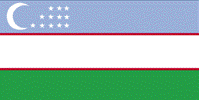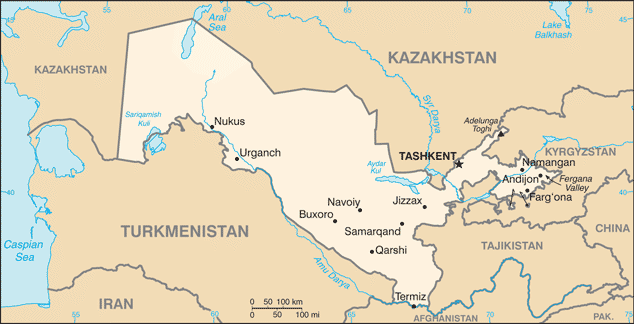Oct 9 2012
Topics Covered
Welcome to Uzbekistan
Overview of Resources
Metals
Fossil Fuels
Investment
Sources
Welcome to Uzbekistan
Uzbekistan, with a total population of 28,394,180 as of July 2012, is located in Central Asia, to the north of Turkmenistan and south of Kazakhstan. The country mostly has a midlatitude desert climate and covers a total area of 447,400 km2.
 |
The national flag of Uzbekistan.
Image Credit: CIA Factbook. |
Since its independence in 1991, the country has been making efforts to expand its agricultural sector and simultaneously develop its petroleum and mineral reserves and hence increase its production in order to stabilize its financial sector.
Uzbekistan is the fifth-largest producer of cotton and the second-largest exporter of cotton in the world. Besides cotton, the country also exports gold, natural gas and hydrocarbons. The global increase in prices over the past years for cotton, gold and natural gas brought about a positive impact on the country’s GDP. Uzbekistan’s GDP as of 2011 was $96.46 billion.
Overview of Resources
Uzbekistan’s mineral resources include petroleum, natural gas, gold, silver, uranium, molybdenum, tungsten, coal, copper, zinc and lead. Uranium, copper and gold are the country’s chief minerals. The country has mineral reserves amounting to more than 1800 in number.
In 2010, the country’s mining sector was affected due to decrease in the production of minerals. This decrease was mainly because of insufficient foreign investments, lack of infrastructure and remote location.

The map of Uzbekistan. Image Credit: CIA Factbook
Metals
In 2010, the Almalyk mining and metallurgical complex (Almalyk GMK ) was the only copper production company in Uzbekistan. The mining of copper in Uzbekistan takes place in the Sary-Cheku and Kalmakyr deposits. Besides mining of copper, the Almalyk GMK is also involved in the mining and processing of lead-zinc-barite ores obtained from the Uch-Kulach deposit in Jizzax Viloyati. In 2010, about 20% of gold and 90% of silver was produced by Uzbekistan’s Almalyk GMK.
The Navoi mining and metallurgical complex and the Almalyk GMK were the chief gold producers in Uzbekistan in 2010. The Muruntau gold deposit in Central Qizilqum is known for its low extraction costs and superior quality ores. The Tamdybulak gold deposit, in the north of Muruntau, is another significant gold deposit in the country. In 2010, the chief gold reserves in Uzbekistan totaled to about 5,300 Mt.
Fossil Fuels
Uzbekistan had 171 discovered natural gas and oil fields as of 2010. The country’s vast hydrocarbon resources prevented its dependence on energy supply from foreign sources. Gas condensate was produced by 17 of the country’s natural gas and oil fields and oil was produced by 51 of Uzbekistan’s natural gas and oil fields.
Since 2003, the country experienced a major decline in its production of oil due to lack of upgraded production equipment that lead to a depletion of some of the country’s oil producing fields. This decrease in oil production is expected to continue until 2013.
In 2010, Uzbekistan had 52 natural gas fields located at 12 of the country’s chief deposits that were located in the Central Ustyurt plateau and on the Uzbek side of the Amu Darya basin. Almost 80% of the gas produced in Uzbekistan is utilized by the country’s heating and electricity production sectors.
In 2010, about 24% of gas produced in Uzbekistan was exported to Tajikistan, Russia, Kyrgyzstan and Kazakhstan.
The monopoly rights for carrying out mining and extraction operations of uranium were owned by the Navoi mining and metallurgical complex. The mineral base at the Navoi GMK comprised 20 uranium deposits.
In 2010, the Boztaus plateau had uranium reserves that amounted to 5,500 t. Uranium exploration in this plateau was carried out by the Chinese company, Uz-China Uran.
Investment
Recent news from the mining sector highlights Oxus Gold’s claim against the Uzbek government for the confiscation of the company’s investments in the Khandiza deposit and the Amantaytau Goldfields.
Despite such negative reports the country still hopes to increase its mineral production capacity by increasing the output of gold, uranium and hydrocarbons within the next 10 years. As part of this plan the country also expects to upgrade its infrastructure and production facilities in its mining and mineral sectors and expand its pipelines.
Uzbekistan has also made efforts to modernize the Navoi and Almalyk GMKs and speed up its gold and copper production operations. The government intends to develop joint ventures with Russian and Asian companies as part of their initiatives to improve the country’s mineral and mining sectors.
With these new developments, Uzbekistan hopes to bring about major changes and improvements in its mining and mineral sectors that will likely repair the country’s economic instability.
Disclaimer: The Author of this article does not imply any investment recommendation and some content is speculative in nature. The Author is not affiliated in any way with any companies mentioned and all statistical information is publically available.
Sources